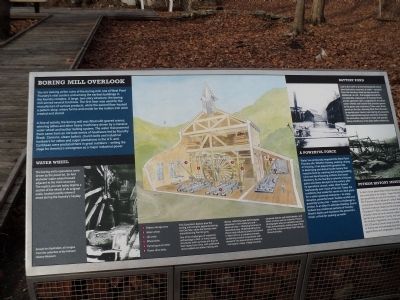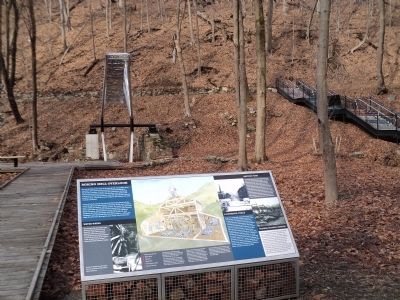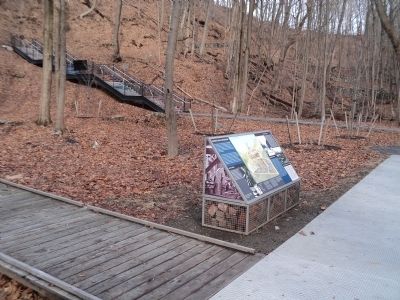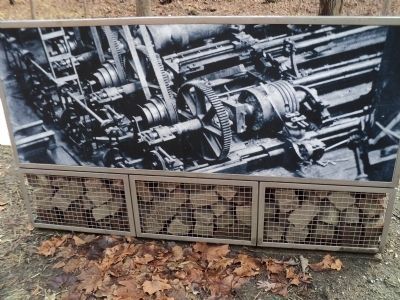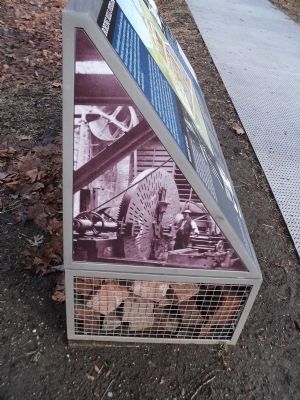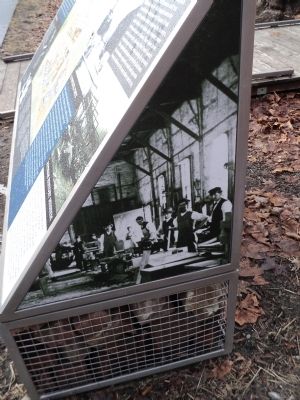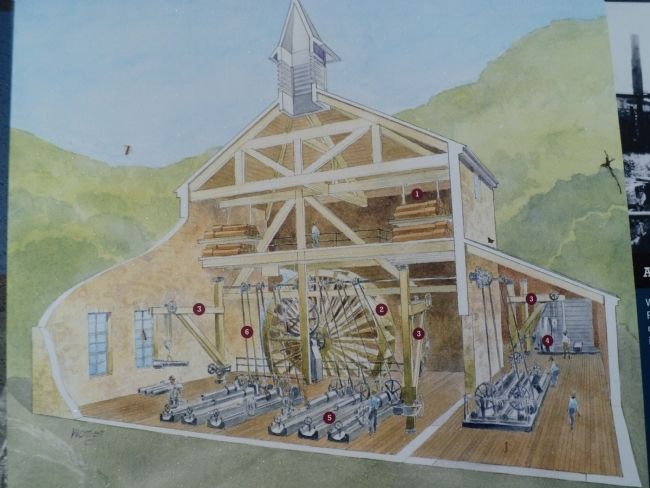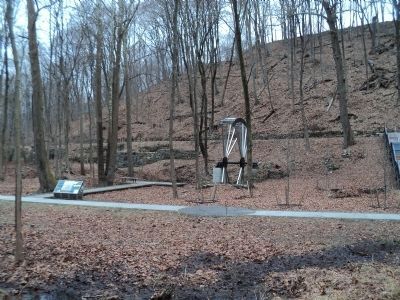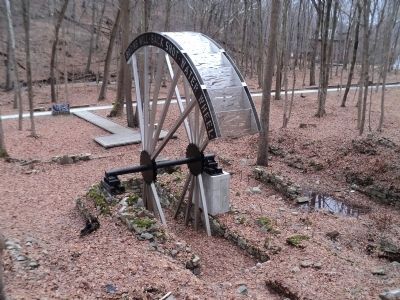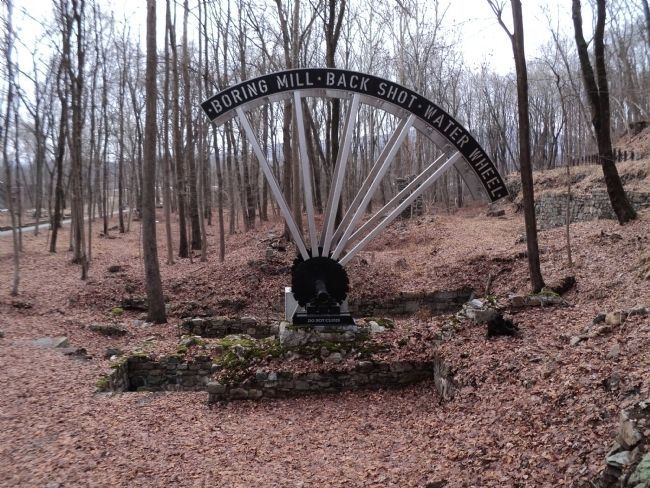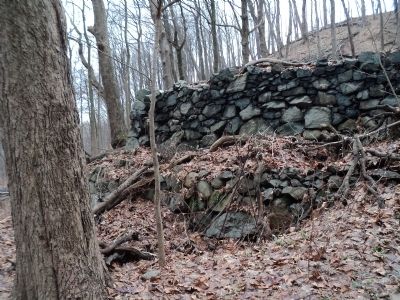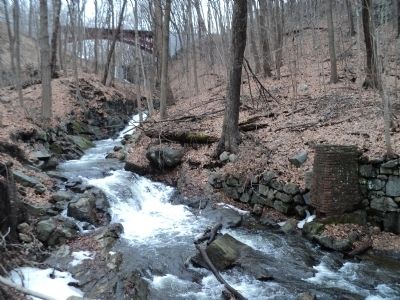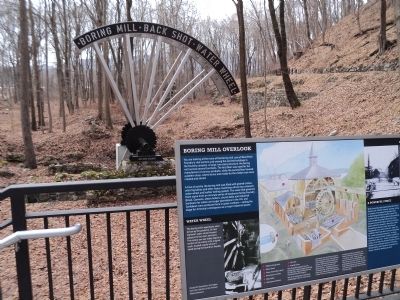Cold Spring in Putnam County, New York — The American Northeast (Mid-Atlantic)
Boring Mill Overlook
You are looking at the ruins of the boring mill, one of West Point Foundry’s vital centers and among the earliest buildings in the foundry complex. A large, two-story structure, the boring mill served several functions. The first floor was used for the manufacture of various products, while the second floor housed a pattern shop, where forms and molds for the molten iron were created and stored.
A hive of activity, the boring mill was filled with geared cranes, whirring lathes and other heavy machinery driven by a massive water wheel and leather belting system. The water that powered them came from an intricate series of headraces fed by Foundry Brook. Cannons, steam boilers, church bells and industrial hardware for cotton and sugar plantations in the U.S. and Caribbean were produced here in great numbers – setting the stage for America’s emergence as a major industrial power.
Water Wheel
The boring mill’s operations were driven by the powerful, 36-foot diameter water wheel housed adjacent to the main structure. The replica you see today depicts a section of the wheel at its original scale, located exactly where it stood during the foundry’s heyday.
Battery Pond
Just to the north is a two-tiered granite stone dam that held a reservoir of water – recycled from the foundry’s blast furnace and from additional run-off – that supplemented the considerable waterpower of Foundry Brook and its upstream dam, supplying the foundry’s water wheels and turbine that provided power to the gears and machinery. There were three ponds on the site, allowing West Point Foundry to operate year-round, even during dry seasons. This sophisticated system perfectly illustrates the innovation required to recreate and operate heavy machinery in the days before electricity.
A Powerful Force
Water has profoundly impacted the West Point Foundry site. Whether flowing, soaking, drying or freezing, it has played the greatest role in destroying and obscuring the history that remains here by cracking and eroding building ruins and decomposing artifacts that await discovery. As the foundry’s network of sluices, gates and dams decayed in the century after its operations ceased, water often flowed haphazardly over much of the site. Today, the conditions that made this ravine an ideal place for a water-powered enterprise – its steep elevation, powerful brook, healthy rainfall and proximity to the river – make it a challenge to protect. In an effort to alleviate flooding, Scenic Hudson has reinforced sections of Foundry Brook’s banks and maintains the preserve’s forest critical for soaking up water.
Putnam History Musuem
To learn more about West Point Foundry and see examples of its output – from Parrott gun projectiles to cast iron furniture – visit the Putnam History Museum, which features a permanent foundry exhibition as well as archival material related to the ironworks. Founded in 1906 to collect, preserve, and present historical and cultural material pertaining to Putnam County, the foundry, and the Hudson Highlands, the museum is located at 63 Chestnut Street (stop 8 on the Red Trail) in the former schoolhouse built for foundry apprentices and employees’ children.
( Sidebar : )
Under an illustration of the mill and water wheel:
1. Pattern storage area
2. Water wheel
3. Jib crane
4. Wheel lathe
5. Parrott guns on lathe
6. Power drive belts
This illustration depicts how the boring mill complex appeared during the Civil War, when the foundry was manufacturing Parrott guns.
One of the challenges of industrial archaeology is that, in many cases, structures such as these are fluid in their layout over time, with additional rooms added and others falling into disuse, reflecting new technologies, advances in raw materials and – above all else – changing fortunes in manufacturing. Understanding how these early industrial sites functioned in their time is a complex process, combining careful excavations with research into documentary evidence – surveyors’ maps, village records, personal diaries and sketchbooks, and other primary source material. Period photographs also are valuable tools that help archaeologists make sense of the ruins that remain at West Point Foundry Preserve today.
Topics. This historical marker is listed in these topic lists: Industry & Commerce • War, US Civil. A significant historical year for this entry is 1906.
Location. 41° 25.001′ N, 73° 56.823′ W. Marker is in Cold Spring, New York, in Putnam County. Marker can be reached from Kemble Avenue, on the left when traveling south. Marker is located along the yellow trail in the West Point Foundry Preserve. Touch for map. Marker is at or near this postal address: 68 Kemble Avenue, Cold Spring NY 10516, United States of America. Touch for directions.
Other nearby markers. At least 8 other markers are within walking distance of this marker. Foundry Brook (a few steps from this marker); a different marker also named Boring Mill Overlook (a few steps from this marker); Jewel of the Hudson (about 300 feet away, measured in a direct line); The 1865 Office Building (about 400 feet away); West Point Foundry Archaeological Site (about 500 feet away); From Forest to Factory to Forest (approx. 0.2 miles away); The West Point Foundry (approx. 0.2 miles away); The West Point Foundry School (approx. 0.2 miles away). Touch for a list and map of all markers in Cold Spring.
Also see . . .
West Point Foundry Preserve. Scenic Hudson website. (Submitted on January 17, 2014, by Bill Coughlin of Woodland Park, New Jersey.)
Credits. This page was last revised on June 16, 2016. It was originally submitted on January 17, 2014, by Bill Coughlin of Woodland Park, New Jersey. This page has been viewed 504 times since then and 17 times this year. Photos: 1, 2, 3, 4, 5, 6, 7, 8, 9, 10, 11, 12, 13. submitted on January 17, 2014, by Bill Coughlin of Woodland Park, New Jersey.
